|
|
|
|
| 2-4 players, 90-120 minutes, 12 years and older |
| Author | Richard Breese |
| Illustrator | Vicki Dalton |
| Published by | R&D Games |
| Online since | 2023-06-17 |
| Developed by | Ezra McNichols (storm1850) |
| Boardgamegeek | 212516 |
| Yucata.de owns a license for the online version of this game. A big "thank you" to the copyright owners (publisher and/or author and illustrator) who make it possible to have this game for free online here! |
| Note: This online implementation uses slightly changed rules! |
|
|
|
|
If you are reading these rules for the first time, ignore the text along the right hand side. These rules serve as a summary to help you quickly familiarize yourself with the game.
Show
→ summary only
→ detailed version only
→ both summary and detailed version

On Yucata the following deviations from the rules apply:
-
When paying some costs, on Yucata, if the player owns both raw resources and finished goods, it sometimes auto-selects raw resources as payment costs (which is always the best thing to do anyways).
-
In the rules it states that all resources are limited. According to the designer, this was primarily done as a cost consideration. The x4 cap on scoring would mean hoarding was largely pointless. On Yucata no such restriction is enforced.
-
After taking tiles, the rules say: "The only exception is that if taking country tiles was the last action of a season, then the tiles are not replenished."
On Yucata this exception is ignored (for simplicity). This means tiles may come out and be immediately discarded.
-
For tiebreakers, the rules specify a large list of tiebreakers.
On Yucata, only the first two tiebreakers are considered - finished goods and wheat. Raw materials and animals are not considered.
-
For simplicity, the game shows incomplete private fairs with the rest of your tiles, and not on the game board upside down (as indicated by the rules).
Set in the lands of Keydom, players use their keyper to manage and recruit a team of skilled workers ('keyples') over four seasons in order to develop their farm and village,
to hold seasonal fairs and to trade with the local boatmen.
Players choose the best combination of fields to which to send their keyples from their keep ('keyp'). The keyples will work in those and other fields to gain resources:
raw materials, wheat, livestock and gems. They may also gain actions: knowledge and assistance from travellers, such as building plans and rewards, and opportunities to trade
with the local boatmen.
The keyples work more productively with a follower who has the same skill, giving players the opportunity to work together for their mutual benefit. In certain circumstances
keyples may additionally work twice during a season, before laying down for a well-earned rest whilst awaiting recruitment for the following season.
The player who best manages their team and creates the most valuable village and trades will be rewarded with the most points to win the game, the acclaim of their fellow
players and the recognition of Keywood, the distant and ageing ruler of the Keydom.
Keyper is a game for 2 to 4 players taking approximately 30 minutes per player.
In Keyper the aim of the game is for each player to create the best economy they can by developing their farm and village,
exploiting shipping opportunities and holding fairs.
All these activities are displayed or recorded by each player on their own player board.
Players start the game in spring with a keyper and an initial team of eight keyples.
The game is played over four seasons: spring, summer, autumn and winter. In later seasons the number and colour of keyples a player has available are likely to vary.
Each season a player's keyples are deployed in order to gather resources and to take actions on the country boards and on the player's own player board.
The keyples acquire building opportunities, raw materials, animals and gems. Raw materials can be converted into finished goods and both,
plus wheat, are used to build and upgrade buildings.
The colour of each keyple identifies that keyple's area of expertise, which will increase the keyple's productivity in fields of the same colour and
allow it to join in on the activities of other keyples of a matching colour.
On the player board the farm and village areas are divided into plots onto which buildings are built. Some of these buildings give special actions whilst
other buildings give point-scoring opportunities. The player board also contains fairground and store locations, a shipping score track and a keyp.
The folding country boards contain fields and shipping opportunities, on which keyples can work alone or together, often on other player's turns, in order
to gain actions and resources.
During each season a player will also play their keyper to claim a country board and the keyples on it for the following season. Players will later manipulate t
he country board in order to choose their preferred selection of fields.
At the end of each season fairs are held to display specific resources that a player has gathered and to gain points.
At the end of the game points are scored for the farm and village buildings that have been built, for the fairs that have been held and from resources shipped during the game.
The player who has created the best economy and therefore generated the most points will win the game.
Keyper is unlike most other board games, in which a player has no more actions to take when they have used all of their pieces (keyples).
In Keyper, once a player has played all of their keyples, they have lay-down opportunities and can start to lay-down those keyples that are then under their control,
so that those keyples can work for a second time.
In Keyper a player can also play keyples of a matching colour as a joiner on other players' turns.
In these circumstances both players will benefit from extra actions or resources.
This gives players opportunities and incentives to play all of their keyples quickly and in the process give themselves additional lay-down opportunities toward the end of a season.
In order to get the maximum benefit from any lay-down actions, players need to take care where they initially place their keyples. Similarly, the country board a player selects with
their keyper will determine how many and which coloured keyples they will recruit for the following season. Fewer keyples will usually give a player more lay down opportunities,
but too few and their opportunities to join in and lay down keyples usefully will be restricted. If a player has more than eight keyples then the excess will take a rest for a season on
the player's keyp tile.
Boards:
Tiles:
Keypers and keyples:
Resources (which include the animeeples):
-
48 Wooden cube raw material counters  : :
16 orange clay  , ,
16 brown logs  and and
16 grey rocks  . .
-
48 Wooden octagonal finished goods counters  : :
16 brown wood  , ,
16 grey stones  and and
16 orange bricks  . .
-
20 Yellow wooden wheat tokens  . .
-
96 Wooden animeeples. 12 each of:
 orange chickens, orange chickens,
 dark-brown cows, dark-brown cows,
 burgundy deer, burgundy deer,
 grey goats, grey goats,
 light-brown horses, light-brown horses,
 pink pigs, pink pigs,
 white sheep and white sheep and
 black wild boar. black wild boar.
-
8 Wooden cylindrical scoring markers,
2 in each of the player colours 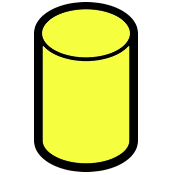 , ,  , ,  and and  . .
-
64 Gems  . 16 each of: . 16 each of:
green emeralds  , ,
yellow gold  , ,
red rubies  and and
blue sapphires  . .
1 Black cloth bag.
2 Rule booklets  and and  . .
-
Place 1 country board per player in the middle of the playing area.
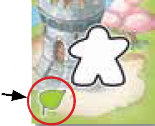 Each country board should display a keyp field with the
Each country board should display a keyp field with the  icon visible. icon visible.
The first board should also display the one-player  icon,
the second board the twoplayer icon icon,
the second board the twoplayer icon  and,
if applicable, the third board the three-player and,
if applicable, the third board the three-player  icon and icon and
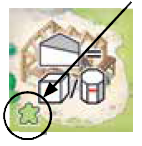 the fourth board the four-player
the fourth board the four-player  icon.
(Note: these player icons are used only for this initial set-up.) icon.
(Note: these player icons are used only for this initial set-up.)
The orientation of the fields on the country boards does not matter.
In some displays the fields will be oriented differently to some of the other fields.
It also does not matter which sides of the country boards are placed next to each other or in what formation.
-
Place the spring country tiles (as identified by a  icon) into the cloth bag. icon) into the cloth bag.
 Shake the bag, draw 8 of these tiles and then place them in two rows next to the country boards with
the side showing the build cost face up. Place the bag with the remaining tiles in easy reach for later use.
Shake the bag, draw 8 of these tiles and then place them in two rows next to the country boards with
the side showing the build cost face up. Place the bag with the remaining tiles in easy reach for later use.
-
 Place all of the other country tiles, together with the winter fair tiles (the fair tiles with season icons on both sides),
in stacks at the side of the playing area.
These tiles will be placed in the cloth bag later in the game.
Place all of the other country tiles, together with the winter fair tiles (the fair tiles with season icons on both sides),
in stacks at the side of the playing area.
These tiles will be placed in the cloth bag later in the game.
-
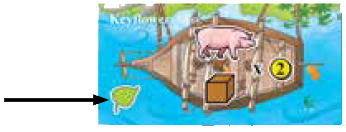 Place 4 of the 6 boat tiles, chosen at random, by the side of the country boards,
with the side showing the
Place 4 of the 6 boat tiles, chosen at random, by the side of the country boards,
with the side showing the  icon face up. Place the remaining two boats to one side.
They will not be required until the start of the icon face up. Place the remaining two boats to one side.
They will not be required until the start of the  season. season.
-
Sort the following components into separate piles and place within easy reach of all players:
3 types 

 of raw materials, of raw materials,
3 types 

 of finished goods, of finished goods,
wheat  , ,
8 types of animeeples 






 and and
4 types of gems 


 . .
Each player now places the following components in their own playing area:
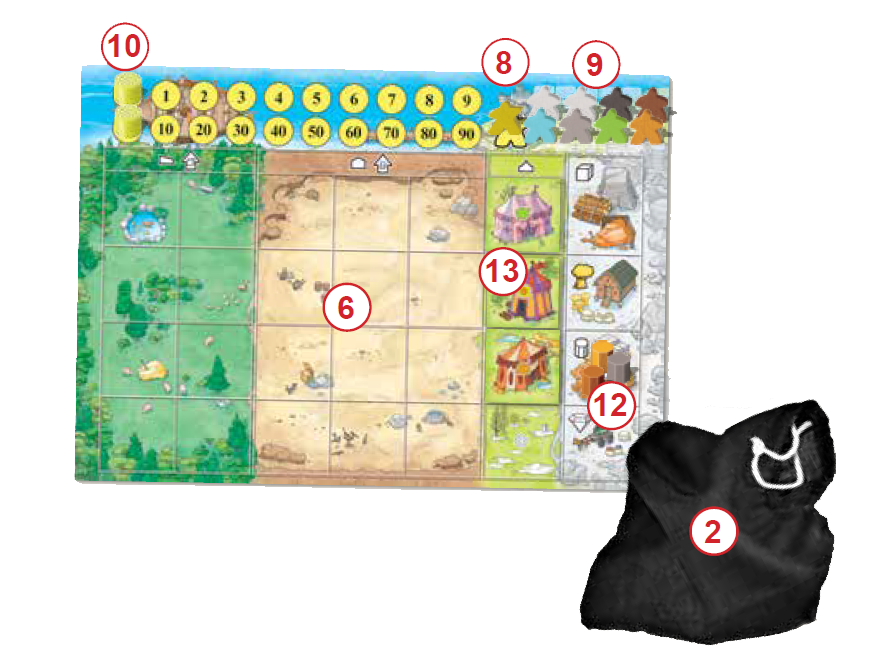
- A player board in their player colour.
-
A keyp tile,
which is placed next to the top right of the player board.
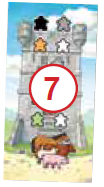
-
A keyper in their player colour
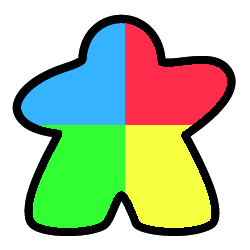 , ,
which is placed in the keyp area on the top right of the player board.
-
A team of 8 keyples:
1 boat person  , ,
1 clay worker  , ,
1 farmer  , ,
1 forest worker  , ,
1 miner  , ,
1 quarry worker  and and
2 generalists   . .
These are placed to the right of the keyper on the footprints at the top right of the player board.
A player's keyper and keyples should always be kept in the keyp area on their player board until they are deployed so the other players can easily
see at all times how many keyples each player has remaining and what colour they are.
In a two-player game both players draw a ninth keyple at random
from a selection of one forest worker
 , one farmer , one farmer  ,
one quarry worker ,
one quarry worker  and one clay worker and one clay worker  .
All the other rules in the game remain the same for the two player game except that at the start of subsequent season each player keeps 9 keyples, not 8. .
All the other rules in the game remain the same for the two player game except that at the start of subsequent season each player keeps 9 keyples, not 8.
-
Two scoring markers
  in their player colour, in their player colour,
which are placed on the zero spaces on the score track at the top of their player board.
-
12 home tiles,
which are placed in two columns to the left of their player board.
The 6 farm tiles  are placed in the left column and the 6 village
tiles are placed in the left column and the 6 village
tiles  are placed in the right column. are placed in the right column.
Place all the tiles with the build cost visible.
-
3 finished goods:
1 brick  , ,
1 stone  and and
1 wood 
are placed in the finished goods store on the player board.
-
The
 , ,  and and
 fair tiles are placed in 3 stacks with the front side face down, 1 stack for each season. fair tiles are placed in 3 stacks with the front side face down, 1 stack for each season.
Each player takes 1 tile from each stack and places these face down on the corresponding fairground spaces on the their player board.
The player may look at the front of these tiles, but need not show them to their opponents.
The remaining tiles are placed back in the game box as they will not be used in this game.
- Finally, choose a start player at random.
The game is played over 4 seasons.
On their own turn a player may:
-
play their keyper onto a country board keyp
-
play a keyple on any country board - ask for joiners if the field is empty
-
play a keyple onto a building tile on their player board
-
if they have no keyples or keyper, they may lay down a keyple so that it works for a second time
On another player's turn, if that player has played onto an empty field, one other player may play a keyple as a joiner.
The number of actions or resources generated by a keyple are as follows:
-
if it is on its own, 1 action or resource
-
if it is joined by another player's keyple, 2 actions or resources
-
if it joins an existing keyple, lay down the existing keyple and gain 2 actions or resources
-
if there is a colour match on a field, 1 additional action or resource
On their own turn a player must undertake one of the following three actions:
- Play a keyper
- Play a keyple
- Lay down a keyple(s)
There are also opportunities to:
- Play a keyple on another player's turn
|
When first played (points 1, 2 and 4 above) a keyper or keyple is always placed standing up.
|
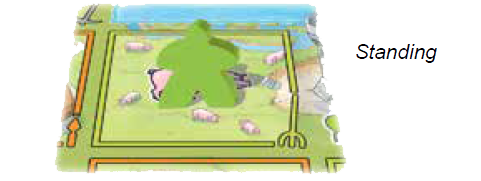
|
|
Under action 3 a keyple may be laid down by placing it on its side.
|
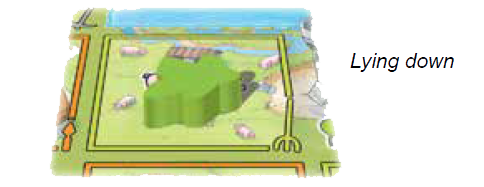
|
When playing or laying down a keyple it is always optional as to whether a player takes any action or resource generated.
Whilst the procedures for performing these actions may look complicated at first,
players should find them logical and straightforward once they are familiar with them.
The main options available from these actions are to:
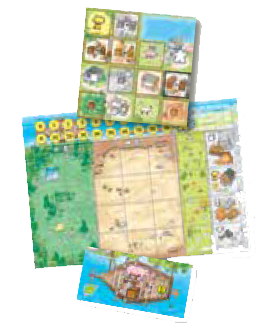
-
gather resources and acquire building tiles from the fields on the country boards,
-
build, up-grade and utilise building tiles on the player's own player board,
-
work on a boat in order to gain resources and/or ship resources for points
Players will also want to save resources for game-end scoring purposes.
Play proceeds in a clockwise direction until all players have played their keyper and all of their keyples, at which point the
end of the season
is triggered.
There are four seasons in the game:  , ,  , ,
 and and  .
The game ends
at the end of the .
The game ends
at the end of the  season. season.
1. Play a keyper
-
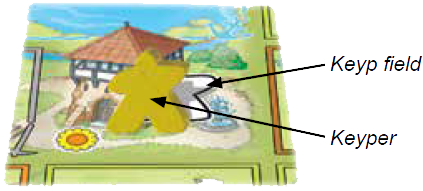 Once per season as their action and at any time a player must play their keyper from the keyp
on their player board onto an empty keyp field on one of the country boards.
Once per season as their action and at any time a player must play their keyper from the keyp
on their player board onto an empty keyp field on one of the country boards.
-
The effect of playing the keyper is to claim the country board that the keyper has been placed on. At end of the season the player will take that country board, together with all of the keyples that are on that country board. At the end of
 , ,
 and and
 these keyples will from part of the player's new team of keyples for the following season, and at the end of these keyples will from part of the player's new team of keyples for the following season, and at the end of
 they will be available for game end scoring purposes. they will be available for game end scoring purposes.
Claiming a country board does not prevent other players from playing keyples onto that country board.
-
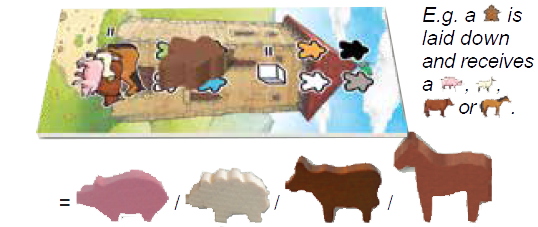 When a player plays their keyper, then they also lay down any keyples that are on their keyp tile.
For each keyple that is laid down the player gains one of the resources (if available) indicated on the keyp tile. A
When a player plays their keyper, then they also lay down any keyples that are on their keyp tile.
For each keyple that is laid down the player gains one of the resources (if available) indicated on the keyp tile. A
 , ,
 , ,
 or or
 keyple gains a raw material keyple gains a raw material
 . A . A
 , ,
 , ,
 or or
 keyple gains a keyple gains a
 , ,
 , ,
 or or
 . .
Note that there will be no keyples on the keyp tiles in
 . Keyples are only placed on the keyp tiles at the start of the . Keyples are only placed on the keyp tiles at the start of the
 , ,
 and and
 seasons. seasons.
-
If a player has not yet played their keyper then they cannot undertake action 3 (iii): lay down a keyple.
2a. Play a keyple
|
A keyple is played from the keyp area of the player's board.
|
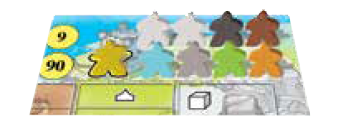
|
|
Any coloured keyple may be played onto either a field on any country board, or a plot
that contains a building tile on the player's own player board.
|
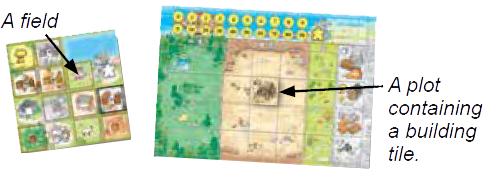
|
|
The field or building tile must either be empty or contain only one keyple, known as an existing keyple.
|
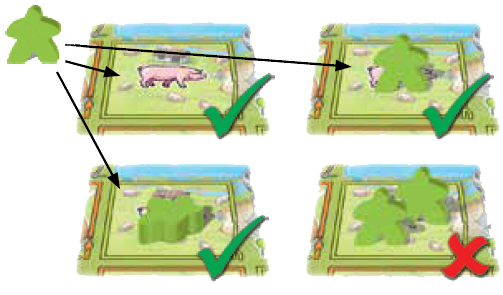
|
|
On its own, a keyple generates a single action or resource. Some fields (but no plots) have a coloured border.
If a keyple is played onto a field that has a coloured border that matches the keyple's colour then the keyple is working in its area of
expertise and the keyple generates a second action or resource.
|
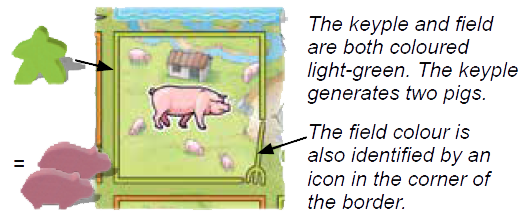
|
A player may play on a country board even if it has been claimed by a keyper, either the player's own keyper or an opponent's keyper.
A keyple cannot be played onto:
-
a keyp field on a country board (where only the keypers are played)
-
a keyp tile
-
an opponent's player board, or
-
a field (including the double sized river space) or plot that already contains two keyples
Once a keyple has been played it no longer belongs to the player who played it. Its previous ownership does not need to be tracked.
2b. Joiners
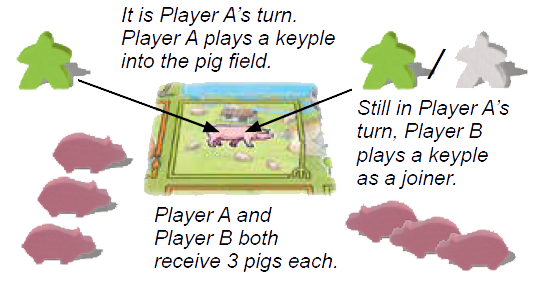 If a field is empty when a keyple is placed on it, the player ('Player A') must invite the other players to place a keyple
onto the same field in order that they can join Player A's keyple. As there is a limit of two keyples per field, only one other player can play a 'joiner'.
If a field is empty when a keyple is placed on it, the player ('Player A') must invite the other players to place a keyple
onto the same field in order that they can join Player A's keyple. As there is a limit of two keyples per field, only one other player can play a 'joiner'.
The player to Player A's left, Player B, gets the first option to join Player A by placing one of their keyples into the same field.
If Player B declines, then in clockwise order, the other player(s) (if any), get the same option to join.
The joining keyple must be either the same colour as the keyple played by Player A, or a white keyple (which can represent any colour).
If another player plays a keyple as a joiner, then Player A's and the joiner's keyples will work together and both keyples will generate an additional action or resource.
| Number of actions or resources received by: | Player A (if no joiner) | Player A and joiner |
|---|
| If no colour match | 1 | 2 |
| If keyple and field colours match | 2 | 3 |
The keyple played by a joiner does not have to take the same action(s) or resource(s) as the player whose turn it is.
If a white keyple has been played on a coloured field, then the white keyple is deemed
to be specialising in the colour of that field and can be joined by either a white keyple or a keyple of the field's colour.
A white keyple played on a field with no colour or a plot can only be joined by another white keyple.
2c. Existing keyples
All keyples have the potential to work twice in each season. To indicate when a keyple has worked for a second time it is laid down.
If the field or plot already contains a keyple (known as an 'existing keyple') from a previous turn, then the keyple being played (by Player A) may become a joiner.
As a joiner the keyple must either be the same colour as the existing keyple or a white keyple.
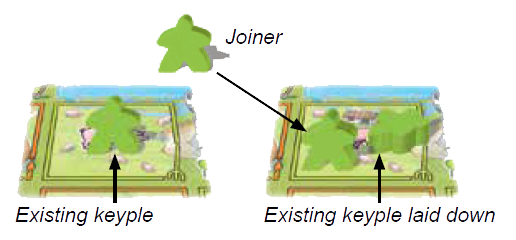 The existing keyple may now be laid down to indicate that it is working for a second time and in order to generate an additional action or resource.
(Occasionally it can be advantageous not to lay down an existing keyple in order to facilitate a lay-down opportunity on a later turn.)
The existing keyple may now be laid down to indicate that it is working for a second time and in order to generate an additional action or resource.
(Occasionally it can be advantageous not to lay down an existing keyple in order to facilitate a lay-down opportunity on a later turn.)
It is permissible to join a keyple that is already lying down.
In these circumstances the lying down keyple cannot work again (for a third time) and the joiner gets the same benefit as if they were working on their own in an empty plot.
The number of resources or actions received by Player A are as follows:
|
Existing keyple:
|
Is laid down as part of action
|
Choose not to lay down (or was already laid down on a previous turn)
|
| If no colour match
| 2 | 1 |
| If keyple and field colours match | 3 | 2 |
If a white keyple is played as a joiner, it counts as the colour of first keyple played, not the colour of the field
(when the colour of the first keyple played is different from the colour of the field).
If the existing keyple is a white keyple and that white keyple has been played on a coloured field,
then the joiner can be a white keyple or a keyple of the same colour as the field. If the existing white keyple
is on a plot or a field with no colour then the white keyple can only be joined by another white keyple.
The actions of an existing keyple and a joiner do not need to be the same action. See the following examples:
-
A light-blue keyple is played onto a boat tile where there is an existing light-blue keyple. The existing light-blue keyple is laid down.
There are three actions available. The possible actions are
-
to work for resources
-
to sell resources
-
to work for one type of resource offered by the boat and to sell the other type of resource.
-
The keyple being laid down could be used to upgrade a tile that it is on, if applicable, and the keyple being placed to take the action on the upgraded tile.
-
If using the upgraded builder tile, the existing keyple could be laid down and used to build a building tile, the joiner could then upgrade the same tile.
3. Lay down a keyple(s)
A keyple may only be laid down when:
-
it is an existing keyple in a field or plot and it is joined on a later turn by another keyple.
-
it is a keyple on a keyp tile that is laid down when the player's keyper is played.
-
a player has no keyper/keyples left in the keyp on their player board when it is their turn to
play and one or more of the other players has a keyper or keyples still to play. If possible, the keyple(s) being laid down must be on either:
-
a plot on the player's own player board
-
a field on the country board that the player has claimed with their keyper.
The following rest of this section relates to the situation in (iii) above.
The field or plot chosen must contain at least one keyple that has not already been laid down.
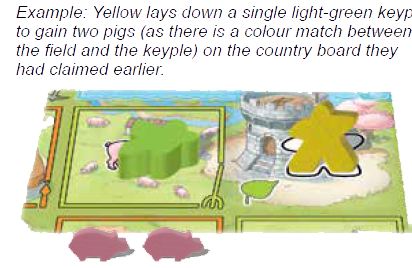 If there is just a single keyple standing in the field or plot, then the player may lay that keyple down to denote that the keyple is working for a second time,
and then gain one action or resource (or two if there is a colour match between the keyple and the field).
If there is just a single keyple standing in the field or plot, then the player may lay that keyple down to denote that the keyple is working for a second time,
and then gain one action or resource (or two if there is a colour match between the keyple and the field).
If there are two keyples still standing, then the player (Player A) may lay down either one, or more usually, both keyples:
one keyple as their turn and the second as a joiner. This denotes that both the keyples have now worked for a second time.
The first keyple, assisted by the joiner, gains two actions or resources (or three if there is a colour match).
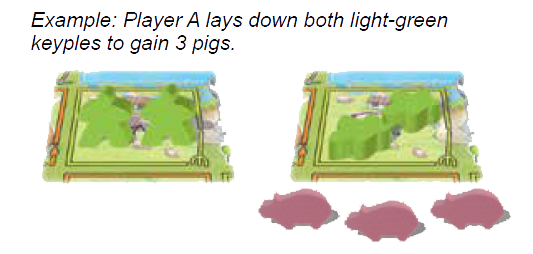 The joiner does not generate additional actions or resources for itself as it is only helping the other keyple laid down by the player.
The joiner does not generate additional actions or resources for itself as it is only helping the other keyple laid down by the player.
If there are two keyples and one of the keyples is already lying down (as it has already worked twice),
then the player may lay down the second keyple in order to denote that this keyple has also worked for a second time and gain
the action or resource (or two if there is a colour match).
The number of actions or resources that Player A gets from laying down a keyple or 2 keyples are as follows:
|
Number of keyples laid down:
|
1
|
2
|
| If no colour match | 1 | 2 |
| If keyple and field colours match | 2 | 3 |
If on Player A's turn, all of the keyples on their player board and the country board they have claimed with their keyper have been laid down
(even if laying them down does not benefit Player A), then Player A may lay down keyples on one of the other country boards, even if that board
has been claimed by another player's keyper.
In these circumstances, re-check the position in each subsequent turn. If another player has subsequently played
onto the country board claimed by Player A, then player A will have to lay that keyple down before they can again lay down keyples on another player's board.
In the unlikely situation that there are no keyples to lay down, then the player does not take an action this turn.
4. Play a keyple on another player's turn
If a player (Player A) plays into an empty field, then Player A must invite the other players to place a keyple into the same field in order to 'join' their keyple.
Firstly the player to Player A's left, Player B, gets the option to join Player A by placing one of their keyples into the same field.
If Player B declines, then in clockwise order, the other player(s) (if any), get the same option to join.
The joining keyple must be either the same colour as the keyple played by Player A or a white keyple (which can represent any colour).
The two keyples work together as a team and are more productive. Both keyples are working for the first time, so neither keyple is laid down.
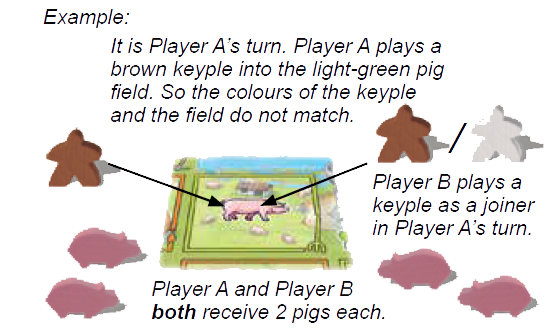 Both keyples generate two resources or actions each if there is no colour match with the field.
Either because the field is a different colour to the keyples or the field is not associated with a colour.
One action or resource as this is the keyple's basic production. A second action or resource as the two keyples are more productive working together.
Both keyples generate two resources or actions each if there is no colour match with the field.
Either because the field is a different colour to the keyples or the field is not associated with a colour.
One action or resource as this is the keyple's basic production. A second action or resource as the two keyples are more productive working together.
If there is a colour match then both keyples are working in their area of expertise and both keyples will generate three actions or resources.
If a white keyple is the joiner it assumes the colour of the first keyple, not the colour of the field if that is different.
The rewards that both Players A and B get from Player B's keyple joining Player A's keyple on Player A's turn are summarised as follows:
| If no colour match | 2 |
| If keyple and field colours match | 3 |
A season ends after the last player plays a keyple/keyper and after all the other players have subsequently had one lay-down action.
At the end of a season players:
-
exhibit at the fairs
-
house any animals
-
claim a country board and retrieve their keyples and keyper
-
 Play continues until all players have played their keyper and all of their keyples.
Play continues until all players have played their keyper and all of their keyples.
 After the last player with a keyper or keyple in their keyp at the start of their turn has played this,
then all of the other player(s) have one more turn in which they can perform a lay-down action.
After the last player with a keyper or keyple in their keyp at the start of their turn has played this,
then all of the other player(s) have one more turn in which they can perform a lay-down action.
Then in order:
-
 If a player forgot to lay down any keyples that are on their keyp tile when they played their keyper, then they may lay their keyples down now and take their chosen resources.
If a player forgot to lay down any keyples that are on their keyp tile when they played their keyper, then they may lay their keyples down now and take their chosen resources.
-
Players now have the opportunity to display resources at the seasonal fairs.
Each player received a spring, summer and autumn fair tile in the set up. These fairs can (only) be held once and in their respective seasons:
 , ,  or or  . .
Players may also have obtained winter fair tiles from a country tile field on a country board.
Each winter fair can be held once at the end of  , ,
 or or  . .
 To hold a fair, a player must display all of the resources required by the fair tile to the other players.
To hold a fair, a player must display all of the resources required by the fair tile to the other players.
A single resource cannot be exhibited at more than one fair in the same season.
If a player exhibits at more than one fair, and some of these require the same resource to be exhibited, then the player must have sufficient of that type of resource
to display at each of the fairs simultaneously. Note: a player can exhibit the same resource at more than one fair if they are held in different seasons.
If all of the required resources are displayed:

-
place the
 , ,  or or
 fair tile face up on that season's fairground space.
(If a player does not have all the resources required then they discard the fair tile into the game box.) fair tile face up on that season's fairground space.
(If a player does not have all the resources required then they discard the fair tile into the game box.)
-
place a
 fair tile onto the fairground space for the season in
which the fair was held, with the icon for that season face up. (If the fair has not been held by the end of fair tile onto the fairground space for the season in
which the fair was held, with the icon for that season face up. (If the fair has not been held by the end of
 , then the player should discard the fair tile into the game box.) , then the player should discard the fair tile into the game box.)
If a player completed more than one fair in a season, then the fair tiles are stacked on the fairground space for that season.
Resources exhibited at fairs are retained by the player and may be used in later seasons or kept for scoring purposes.
-
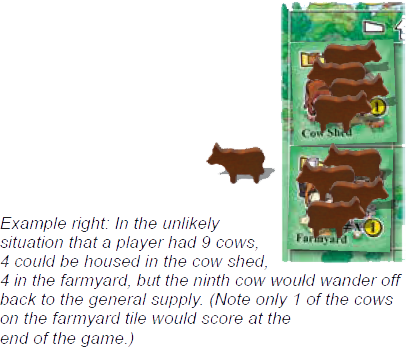 Next, players check that all of their animals are being housed in farm buildings on their player board.
Up to a maximum of four animals may be kept on a farm tile if that type of animal is depicted on that farm tile.
Without a corresponding farm tile an animal is returned to the general supply.
Next, players check that all of their animals are being housed in farm buildings on their player board.
Up to a maximum of four animals may be kept on a farm tile if that type of animal is depicted on that farm tile.
Without a corresponding farm tile an animal is returned to the general supply.
-
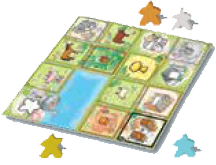 Each player the retrieves their keyper, the country board their keyper was placed on and any keyples that were on that country board.
The keyper and keyples are placed in the keyp on the player's player board together with any keyples on the player's player board and keyp tile.
Each player the retrieves their keyper, the country board their keyper was placed on and any keyples that were on that country board.
The keyper and keyples are placed in the keyp on the player's player board together with any keyples on the player's player board and keyp tile.
At the end of  keep the visible side of the country board unchanged as this may need to be referred to for scoring purposes. keep the visible side of the country board unchanged as this may need to be referred to for scoring purposes.
-
If it is the end of
 , go to End of game and ignore the rest of this section. , go to End of game and ignore the rest of this section.
-
 Place all of the country tiles that were on display at the end of the season (which is usually 8 tiles) onto a discard pile.
Place all of the country tiles that were on display at the end of the season (which is usually 8 tiles) onto a discard pile.
-
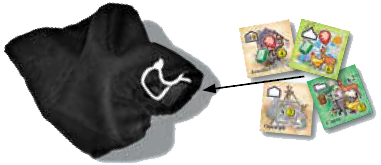 At the end of
At the end of  place all of the non-spring country tiles and the winter fair tiles into the cloth bag
(if they have not already been placed there) and mix in the bag with the remaining place all of the non-spring country tiles and the winter fair tiles into the cloth bag
(if they have not already been placed there) and mix in the bag with the remaining  tiles. tiles.
At the start of the next season players:
-
draw new country tiles
-
replace the boats
-
select a side of their country board
-
place any keyples in excess of 8 (9 if
 ) in their keyp ) in their keyp
The last player who played a keyple/keyper in the previous season becomes the new start player.
In order:
-
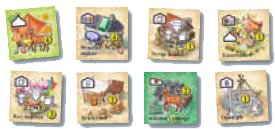 Draw a new set of country tiles from the bag so that 8 new tiles are laid out.
Draw a new set of country tiles from the bag so that 8 new tiles are laid out.
-
Shuffle the 6 boat tiles. Place 4 of these tiles, chosen at random, next to where the country boards will be placed, with the side showing that season's icon face-up. Place the remaining 2 boat tiles to one side.
They will not be available during this new season.

-
Players now select which fields to display on their country board.
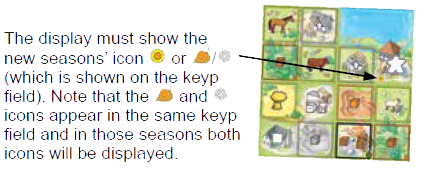
The board must comprise of 15 fields (with the double sized river space counting as one field).
All players reveal their country boards simultaneously and place these next to each other in the middle of the playing area.
-
If a player has more than 8 keyples (or 9 keyples in the two player game) then they choose a number of these to place standing up onto
their keyp tile in order to reduce their team to 8 keyples (or 9 keyples in the two-player game).

-
The player who played the last keyple or keyper from their keyp on their turn in the previous season becomes the start player in the new season.
(This is the player who did not get a lay-down action at the end of the previous season.)
The game finishes after the  fairs. fairs.
At the end of the game add the points from the shipping score track,
farm tiles, village tiles and fair tiles.
The player with the most points wins the game!
The game ends at the end of the  season. Each player then adds the points from their: season. Each player then adds the points from their:
- shipping score track
- farm tiles
- village tiles
- fair tiles
All resources and keyples can now be moved around freely and allocated to the building tiles for scoring purposes.
Resources do not score points unless they are allocated to a building tile.
When scoring note the following:
-
Resources and keyples can only be scored once each.
Example: the same gem cannot be scored by both the prospector and the ring maker.
-
Building tiles may be included in the scoring possibilities of other tiles more than once.
Example: the same building tile could be scored by the drainage, pavements, statue, thatcher and village hall tiles.
-
Each building tile which scores resources or keyples can be scored a maximum of 4 times.
If more than 1 resource is required in order to score, then each set of resources required can be scored 4 times.
Examples:
An upgraded farmyard can score the maximum 8 points if a cow, horse, pig and sheep are on the tile.

The upgraded scrap dealer can score 8 points if a total of 8 gems, finished goods, wheat and/or raw materials are allocated to this tile.
The upgraded cluck cluck chicken house can score 12 points if 4 chickens are on this tile.

The upgraded goldsmith can score 24 points if there are 4 emeralds, 4 gold and 4 sapphires on this tile.

-
All the completed fair tiles in a stack are scored at the end of the game, even if they are covered up.
-
Building tiles that have been overbuilt are not scored.
The player who most effectively managed their economy and scored the most points wins the game.
If there is a tie, the tie is broken in favour of the player who has the most gems.
If there is still a tie, the tie is broken in favour of the player who has the most finished goods, wheat, raw materials, deer, wild boar, goats, chickens, horses, cows, pigs or sheep, considering each resource in that order.
If a player is using a field or building tile (e.g. trading post) to perform a 1:2 trade more than once, and they only have one resource of the required type,
then they may always use a resource received from their first trade to provide a resource for a subsequent trade.
All resources are limited. If two players are obtaining resources on the same turn and the supply is likely to run out,
then the player whose turn it is takes a resource first, then the joining player takes a resource, and they then continue alternating.
A player does not receive anything in compensation if there are insufficient resources.
Trading between players is not allowed.
The country boards are the main source of resources, country tiles and building actions.
At the beginning of  , ,
 and and  players have the opportunity to manipulate one of the boards to choose a display of fields that best meets their objectives.
players have the opportunity to manipulate one of the boards to choose a display of fields that best meets their objectives.

The chosen display must contain 15 fields (counting the double-sized river space as one field), including the keyp field showing the season icon for the new season.

In each season there are four unique ways to display the fields on a country board. (Note the two lay-outs on the far right for
 and and  display the same fields.) The sides available for the display the same fields.) The sides available for the
 and and  seasons are the same. seasons are the same.
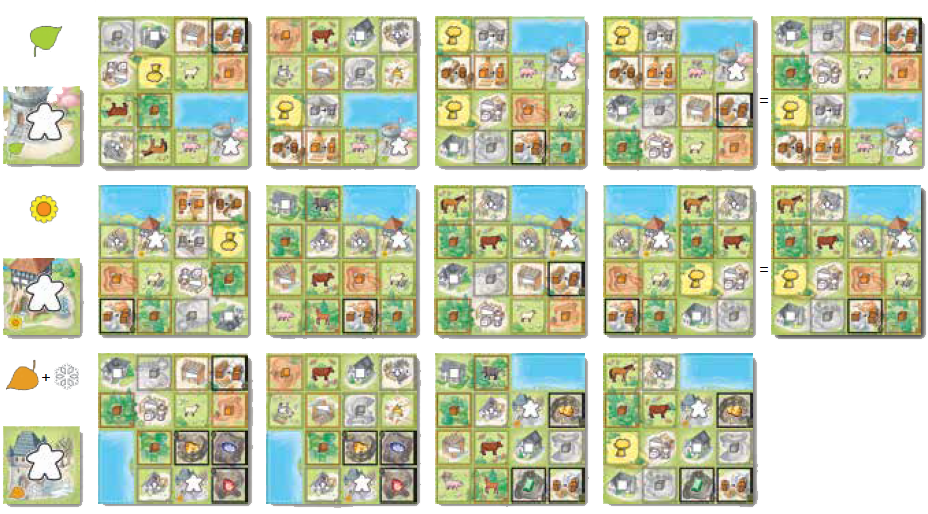
 To assist identification, each coloured field also has a icon in the corner of the field's coloured border:
To assist identification, each coloured field also has a icon in the corner of the field's coloured border:
 , ,  , ,
 , ,  , ,
 or or  .
(If you are playing the Keyper Character Edition, you will see that the character keyples also carry the same tools, which may assist colour-blind players). .
(If you are playing the Keyper Character Edition, you will see that the character keyples also carry the same tools, which may assist colour-blind players).
Using the country boards
In order to gain the resources, country tiles and building actions offered by the fields on the country boards, keyples are played onto those fields.
See A player"s turn
Players place any resources obtained on their player board. Animals are placed in the farm and can wander around freely during a season,
however they must be housed on a tile that depicts that type of creature at the end of the season or they are lost. Other resources:
raw materials, wheat, finished goods and gems, are placed in the relevant store for that type of resource.
Note that not all resources are available from the country boards in each season.
For example there are no chickens available in  and there are no gem fields available in and there are no gem fields available in
 or or  . .
The table below details the actions and resources that are generated from each type of field, depending on whether a keyple is played on its own,
whether there is a joiner and whether there are any keyples laid down.
The colour of each field type is identified, together with the seasons in which it is possible to choose that type of field.
Some field types on the country boards are mutually exclusive.
The table is for reference as required. Players do not need to absorb this table before playing the game!
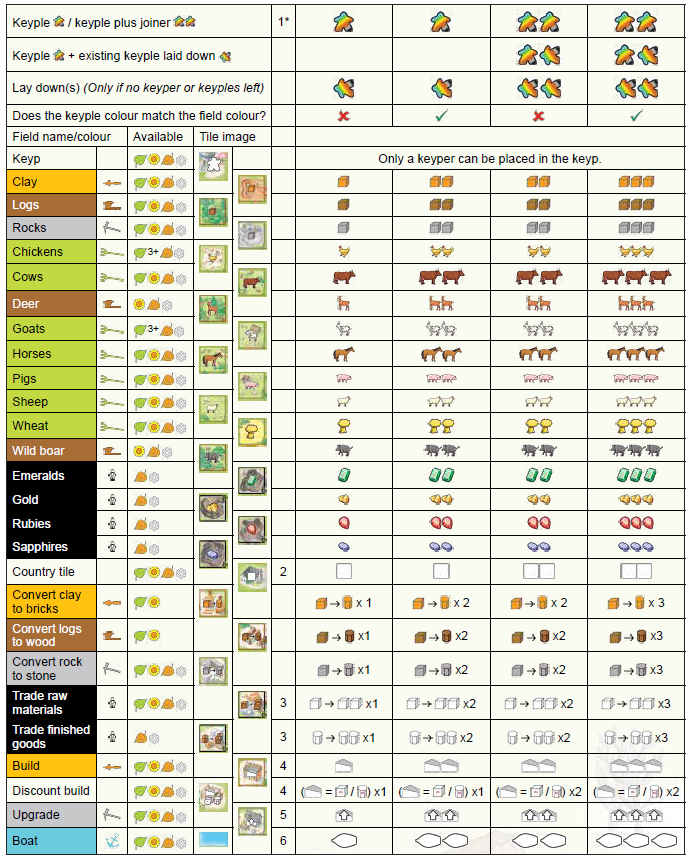
-
A joiner receives the same number of actions or resources as the player whose turn it is.
-
Country tiles (including winter fair tiles).
Obtaining and exploiting the  country tiles is key to assisting players in devising a strategy and successful game-play! country tiles is key to assisting players in devising a strategy and successful game-play!
 Country tiles are obtained from the country tile field. Note it does not cost anything to obtain a country tile, only to build it.
The country tile(s) selected are placed by the side of the player board.
Country tiles are obtained from the country tile field. Note it does not cost anything to obtain a country tile, only to build it.
The country tile(s) selected are placed by the side of the player board.
The country tile field does not have a coloured border, so a single keyple will only get one country tile.
However, if there is a joiner, both keyples will get 2 country tiles. The player whose turn it is gets the 1st and 4th choices and the joiner gets 2nd and 3rd choices.
After a player and any joiner have taken their country tiles, replenish with tiles from the bag so that there are again 8 displayed.
The only exception is that if taking country tiles was the last action of a season, then the tiles are not replenished.
If during all  of the of the  tiles have been drawn and the bag is empty, place all of the country tiles from the stacks set aside during the Set up into the bag.
If the bag is emptied at any time during
tiles have been drawn and the bag is empty, place all of the country tiles from the stacks set aside during the Set up into the bag.
If the bag is emptied at any time during  , ,  or
or  , then the bag is immediately re-filled with the country tiles from the discard stack. , then the bag is immediately re-filled with the country tiles from the discard stack.
The 8 country tiles are displayed so that the initial side, showing the building cost, is visible. Winter fair tiles are displayed with the icon of the current season face up.
The  icon is on both sides of these tiles.
In icon is on both sides of these tiles.
In  display the side of the fair tile with the display the side of the fair tile with the  and and  icons showing. icons showing.
-
Trading 1 for 2 raw materials or finished goods.
A player may use one of the resources received from the first trade in a second or subsequent trade.
-
Building
A player must already possess the building tile they wish to build. Either one of their home tiles or a building tile obtained from a country tiles field.
A player places the building tile to be built on the chosen plot on their player board with the initial side face up. The tile can be built by playing a keyple onto:
-
an orange build field on a country board,
-
a discount build field on a country board
-
the builder tile
-
the farm labourer tile (farm buildings only)
-
the building tile that is being built, which is placed on the chosen plot on the player's player board.
The advantage of this option is that the player gets to keep the keyple. The disadvantage is that it uses one of the
opportunities to use that tile during the season and also that no other player can join in on the build action.
(Note, if this keyple is subsequently laid down on a later turn it could be used to upgrade or activate the tile.)

The player must pay the build cost as shown on the building tile or as modified under (ii), (iii) or (iv) above.
Note however that (excluding the farm labourer) there is always a minimum cost of one resource when building a building tile using a discount.
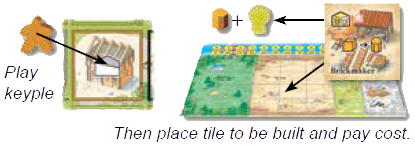
-
Upgrading building tiles
A building tile that has already been played onto the player's own player board can be upgraded by playing a keyple onto:
-
a grey upgrade field on a country board,
-
the upgraded builder tile,
-
the upgraded farm labourer tile, or
-
The building tile on the player's player board that is being upgraded.
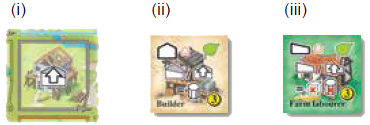
The player must pay the upgrade cost as shown on the player board or as modified by (ii) or (iii) above. The upgraded tile is turned over to reveal the upgraded side.
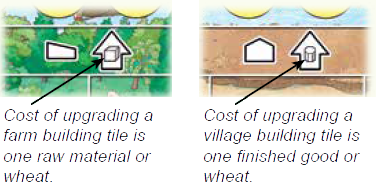
A building tile can still be upgraded if there is a keyple already on the building.
-
Boat tiles
When a player wants to play on a river space, they select the boat of their choice from those that are still available.
They place the boat on their preferred river space and then place their keyple on the boat tile.
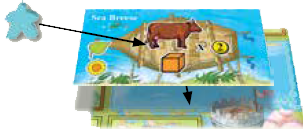
A keyple normally has one action on a boat 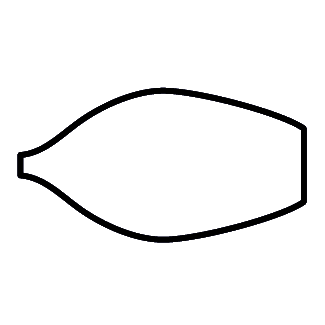 .
If the keyple is light-blue or white, it matches the light-blue colour of the river space and the keyple has two boat actions .
If the keyple is light-blue or white, it matches the light-blue colour of the river space and the keyple has two boat actions
  .
If there is a joiner, then both the keyple and the joining keyple have a third boat action .
If there is a joiner, then both the keyple and the joining keyple have a third boat action
   . .
For each boat action  a keyple may: a keyple may:
-
work on the boat. Then they receive a resource of a type depicted on the boat from the general supply (if available)
-
sell a resource. Return a resource depicted on the boat to the general supply and receive 2 points. Record these points immediately on the shipping score track on the player's player board.
(These are the only points recorded on the score track during the game.)
A keyple cannot receive a resource and sell the same type of resource on the same turn.
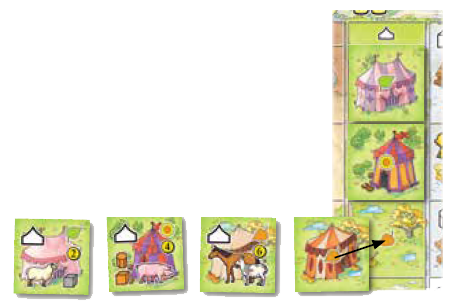 During the Set up, each player receives a
During the Set up, each player receives a  , ,  and
and  fair tile. These tiles are kept face down (with the tent and season icon only showing)
on the fairground spaces on the player's player board (see right) until the fairs can be held. fair tile. These tiles are kept face down (with the tent and season icon only showing)
on the fairground spaces on the player's player board (see right) until the fairs can be held.
The front of these tiles depicts the resources that must be exhibited in order to hold the fair at the end of the season.
(Hint: In the relevant season, temporarily place the resources to be displayed at the end of season fair onto that season's tiles as a reminder not to spend them before the fair is held!)
In addition there are 8 winter fair tiles which can be obtained (when available in the display of 8 country and winter fair tiles) from the country tile field on the country boards.
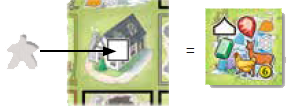
It is suggested that the winter fair tiles are kept to the left of the player's player board (with the home and country tiles)
until the required resources are displayed at an end of a season fair.
The small gem icons in the left corner of the  / /  side of the winter fair tiles are for reference only, in order to identify the gem requirement on the other (
side of the winter fair tiles are for reference only, in order to identify the gem requirement on the other (  /
/  ) side of the tile. ) side of the tile.
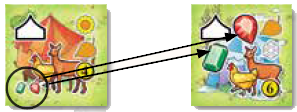
The fairs shown on the winter fair tiles can be held in  or or  (for 4 points) or in
(for 4 points) or in  or or  (for 6 points), depending on which resources are exhibited. (for 6 points), depending on which resources are exhibited.
See also End of season
Tile lay out
Each building tile follows the same lay out.
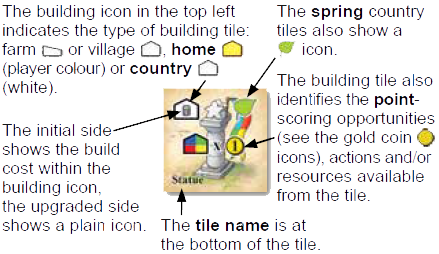
A  icon at the top of the tile denotes that a keyple must be placed (or laid down) on the tile to activate it. icon at the top of the tile denotes that a keyple must be placed (or laid down) on the tile to activate it.
Acquiring building tiles
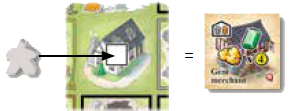 Each player starts the game with the same set of 12 home tiles.
The country tiles are obtained during the game by placing a keyple on a country tile field on one of the country boards.
Each player starts the game with the same set of 12 home tiles.
The country tiles are obtained during the game by placing a keyple on a country tile field on one of the country boards.
It is recommended the player's unbuilt tiles are kept to the left of the player's player board with the side showing the cost of the building face up.
Building a building tile
To score points a building tile must have been built on the player's player board.
Farm tiles  must be built in the farm.
Village tiles must be built in the farm.
Village tiles  must be built in the village.
A player is allowed to connect the sides of village tiles depicting a river to the land side of another building tile.
There is no requirement to connect the sides of village tiles that depict a river. must be built in the village.
A player is allowed to connect the sides of village tiles depicting a river to the land side of another building tile.
There is no requirement to connect the sides of village tiles that depict a river.
Building tiles are always placed same way up, with the name of the tile at bottom. Building tiles cannot be repositioned or rotated once they have been placed on the player board.
If it becomes an issue, then when two players are both building or upgrading (one player having joined the other) the players decide on what they are building,
one building at a time, starting with the player whose turn it is and then alternating.
Upgrading building tiles
Building tiles, once built, can be upgraded.
Overbuilding building tiles
Players are allowed to build over existing building tiles and the build cost will remain the same. Each building tile can only be overbuilt once.
Place the new building tile on top of the original building tile. Do not discard the building tile underneath.
Overbuilt building tiles are no longer operational (unlike any stacked fair tiles), do not score points at the end of the game and are not scored by other tiles,
e.g. by the drainage, pavement, statue or thatcher tiles.
A player can overbuild a building tile even if there is a keyple on the tile being overbuilt. Temporarily remove and then replace the keyple onto the new tile. If desired, that keyple can then be laid down on a subsequent turn in order to take the action or production offered by the new tile or upgrade the new tile.
Building tiles in detail
Each player receives 12 home tiles in their player colour in the Set up: 6 farm tiles and 6 village tiles.
Each building tile has two sides.
An initial side that shows the build cost within the building icon 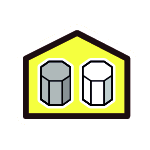 and an
upgraded side which shows a plain building icon and an
upgraded side which shows a plain building icon  . .
When a red-outlined white keyple icon  is shown after the tile name in these rules
(and after the building icon at the top of the building tile), it denotes that a keyple must be placed on the tile to activate it. Other tiles do not need to be activated. is shown after the tile name in these rules
(and after the building icon at the top of the building tile), it denotes that a keyple must be placed on the tile to activate it. Other tiles do not need to be activated.
Farm Tiles
Cow Shed


Up to 4 cows can be housed in the cow shed. At the end of the game each cow housed in the cow shed scores 1 point. (Max. 4 pts.)
If the tile is upgraded then the owner scores 2 points for each cow housed. (Max. 8 pts.)
Pig Sty


Up to 4 pigs can be housed in the pig sty. At the end of the game each pig housed in the pig sty scores 1 point. (Max. 4 pts.)
If the tile is upgraded then the owner scores 2 points for each pig housed. (Max. 8 pts.)
Sheep Shelter


Up to 4 sheep can be housed in the sheep shelter. At the end of the game each sheep housed in the sheep shelter scores 1 point. (Max. 4 pts.)
If the tile is upgraded then the owner scores 2 points for each sheep housed. (Max. 8 pts.)
Stable


Up to 4 horses can be housed in the stable. At the end of the game each horse housed in the stable scores 1 point. (Max. 4 pts.)
If the tile is upgraded then the owner scores 2 points for each horse housed. (Max. 8 pts.)
Farmyard


Any 4 of the following animals can be housed in the farmyard: cow, horse, pig and sheep. E.g. 3 cows and 1 pig.
At the end of the game each different type of these 4 animals in the farmyard scores 1 point. (Max. 4 pts.)
If the tile is upgraded then the owner scores 2 points for each different type of animal housed. (Max. 8 pts.)
Paddock


Any 4 of the following animals can be housed in the paddock: chicken, deer, goat and wild boar.
E.g. 1 goat and 2 wild boar. At the end of the game each different type of these 4 animals in the paddock scores 1 point. (Max. 4 pts.)
If the tile is upgraded then the owner scores 2 points for each different type of animal housed. (Max. 8 pts.)
Village Tiles
Brickmaker


The brickmaker converts 1 clay (orange raw material) into 1 brick (orange finished good).
If the tile is upgraded then the brickmaker converts 1 clay into 2 bricks and the brickmaker tile is worth 5 points at the end of the game.
Carpenter


The carpenter converts 1 log (brown raw material) into 1 wood (brown finished good).
If the tile is upgraded then the carpenter converts 1 log into 2 wood and the carpenter tile is worth 5 points at the end of the game.
Stonemason


The stonemason converts 1 rock (grey raw material) into 1 stone (grey finished good).
If the tile is upgraded then the stonemason converts 1 rock into 2 stone and the stonemason tile is worth 5 points at the end of the game.
Scrapyard


The scrapyard converts 2 raw materials of any type (clay, log or rock) into 1 finished good of any type (brick, stone or wood).
If the tile is upgraded then the scrapyard converts 1 raw material of any type into 1 finished good of any type and the scrapyard tile is worth 3 points at the end of the game.
Drainage


This tile is worth 1 point at the end of the game plus 1 point for each village (not farm) tile positioned diagonally from the drainage tile. (Gaps are allowed.) (Max. 5 pts.)
If the tile is upgraded then the tile is worth 2 points at the end of the game, plus 2 points for each village tile positioned diagonally from the drainage tile. (Max. 10 pts.)
Example:
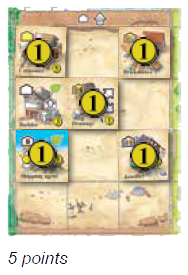
Pavements


This tile is worth 1 point at the end of the game plus 1 point for each village (not farm) tile positioned orthogonally from the pavements tile. (Gaps are allowed.) (Max. 6 pts.)
If the tile is upgraded then the tile is worth 2 points at the end of the game, plus 2 points for each village tile positioned orthogonally from the pavements tile. (Max. 12 pts.)
Example:
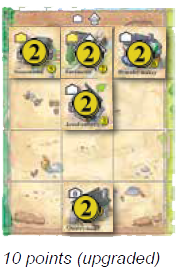
In addition to the home building tiles (farm and village)
there are country building tiles which can be obtained
from the country tile field on the country board.
Spring country tiles
The country tiles have a  icon on
the top right of the tile. All of the icon on
the top right of the tile. All of the  tiles are placed in the
cloth bag at the beginning of the game. tiles are placed in the
cloth bag at the beginning of the game.
Alchemist


The alchemist tile converts 2 raw materials of any type into 1 gem of any type and is worth 3 points at the end of the game.
If the tile is upgraded then it converts 1 raw material of any type into 1 gem of any type and is worth 5 points at the end of the game.
Barn


This tile is worth 1 point for each farm building tile in the farm on the player's player board at the end of the game (including the barn). (Max. 8 pts.)
If the tile is upgraded then the tile is worth 2 points for each upgraded farm building tile in the farm at the end of the game,
but no points for any farm building which is not upgraded. (Max. 16 pts.)
Boarding House


If there is a village (not a farm) tile built on the left or the right of the boarding house, then each of these scores 2 points at the end of the game. (Max. 4 pts.)
If the tile is upgraded, then village (not farm) tiles built on all sides of the boarding house score 2 points each. (Max. 8 pts.)
Builder


The builder enables any building tile to be built at a cost of 1 finished good. (The build cost shown on the tile being built is irrelevant.)
If the tile is upgraded then the builder can be used to build or upgrade any building tile at a cost of 1 finished good or wheat.
The upgraded tile is worth 3 points at the end of the game.
Building Plot


Once the building plot has been built, a building can be built at no cost on the plot to the right of the building plot (even on the same turn that the building plot is built if the player has 2 build actions). To build onto that plot a build action must still be used, but the build cost on the tile being built is ignored. The tile is worth 1 point at the end of the game.
If the tile is upgraded, then 2 more buildings can be built at no cost, 1 in each of the plots above and below the building plot, and the upgraded tile is worth 3 points at the end of the game.
Cluck Cluck Chicken House


Up to 4 chickens can be housed in the cluck cluck chicken house. At the end of the game each chicken housed in the cluck cluck chicken house scores 2 points. (Max. 8 pts.)
If the tile is upgraded then the owner scores 3 points for each chicken housed. (Max. 12 pts.)
Dock


The dock tile will give an additional 6 points at the end of the game if the owner of the tile has scored 20 shipping points during the game.
If the tile is upgraded then it will give 12 points at the end of the game if the owner has scored 30 shipping points (but will no longer get the 6 points if more than 20 but fewer than 30 points have been scored).
Farm Labourer


The farm labourer tile enables any farm building tile to be built at no cost. (The build cost shown on the tile being built is irrelevant.)
If the tile is upgraded then it can be used to build or upgrade any farm building tile at no cost. The upgraded tile is worth 3 points at the end of the game. If a second action is generated on the upgraded farm labourer, e.g. when a joiner joins an existing keyple, then the 2 keyples may perform different actions, for example one may perform a build action and the other an upgrade action. They could even build and upgrade the same building.
The farm labourer tile can be used to build over itself, but it cannot be used again afterwards.
Gem Dealer


The gem dealer tile converts any 1 gem into 1 gem of any type.
If the tile is upgraded then it converts 1 gem into 2 gems of any type (including the same type) and the tile is worth 3 points at the end of the game.
Goat Pen


The goat pen tile can house up to 4 goats. At the end of the game each goat housed in the goat pen scores 2 points. (Max. 8 pts.)
If the tile is upgraded then the owner scores 3 points for each goat housed. (Max. 12 pts.)
Hop Field


The hop field tile converts 1 wheat into 1 animal of any type. The hop field can hold up to 4 animals of any type (as all the animals are depicted in the tile).
If the tile is upgraded then it converts 1 wheat into any 2 animals. The upgraded tile is worth 3 points at the end of the game.
Jewel Cutter


The jewel cutter tile converts 1 stone into 1 gem of any type.
If the tile is upgraded then it converts 1 stone into 2 gems of any type and the tile is worth 3 points at the end of the game.
Livestock Market


The livestock market tile converts 1 animal into 1 animal of any type.
The livestock market can hold up to 4 animals of any type (as all the animals are depicted in the livestock market tile).
If the tile is upgraded then it converts 1 animal into any 2 animals (including the same type). The upgraded tile is worth 1 point at the end of the game.
Oast House


The oast house tile scores 4 points at the end of the game if all of the 8 plots in the owner's farm contain a building tile.
If the tile is upgraded and all of the 8 plots in the owner's farm contain a building tile, then the oast house tile scores 8 points at the end of the game.
Seafarer


Every time the owner of the seafarer tile plays on a boat tile (including as a joiner) the player receives 1 shipping point.
If the tile is upgraded, then every time a player plays on a boat tile the player receives 2 shipping points.
In addition the upgraded seafarer tile is worth 3 points at the end of the game.
These points are recorded immediately on the shipping score track.
If a joiner is played onto a boat tile where there is an existing keyple (which is then laid down),
or two keyples are laid down in a lay-down action, then this still counts as one boat action and scores 2 points, not 4 points.
Shipping Agent


When the owner of the shipping agent tile sells 2 resources to a boat they receive 1 extra point.
If the tile is upgraded then the owner gets 1 additional point for every resource they sell to a boat. The upgraded shipping agent tile is worth 3 points at the end of the end of the game.
Statue


The owner gets 1 point for each home village (not farm) tile they have built in their village. (Max. 6 pts.)
If the tile is upgraded then the owner gets 2 points for each upgraded home (not farm) village tile
(but no points for any home village tiles that are not upgraded). (Max. 12 pts.)
Thatcher


The owner gets 1 point for every 2 village (not farm) tiles that they have built in their village (including the thatcher). (Max. 6 pts.)
If the tile is upgraded, then the owner gets 1 point for each upgraded village (not farm) tile (but no points for any village tiles that are not upgraded). (Max. 12 pts.)
Trading Post


The trading post allows the owner to exchange 1 raw material of any type into 2 raw materials of any type, or to exchange 1 finished good of any type into 2 finished goods of any type.
If the tile is upgraded then it allows the owner to exchange 1 raw material of any type into 2 raw materials of any type and to exchange 1 finished good of any type into 2 finished goods of any type. The upgraded trading post tile is worth 3 points at the end of the game.
Wheat cannot be used in trades at the trading post.
Village Hall


If all of the 12 plots in the owner's village have been built on, then the village hall tile scores 6 points.
If the tile is upgraded and all of the 12 plots in the owner's village have been built on, then the village hall tile scores 12 points.
Windmill


The windmill tile converts any 1 raw material into 2 wheat.
If the tile is upgraded then at the end of the game each wheat, up to a maximum of 4, held in the windmill scores 2 points. (Max. 8 pts.)
Country tiles
The following country tiles are not spring country tiles
and do not have a  icon on the top right of the tile. At the
beginning of the game these tiles and the winter fair tiles
are stacked together. They are placed in the cloth bag at
the end of icon on the top right of the tile. At the
beginning of the game these tiles and the winter fair tiles
are stacked together. They are placed in the cloth bag at
the end of  , or earlier if the bag is emptied. , or earlier if the bag is emptied.
Boatman


The owner scores 1 point for each light-blue keyple that they have at the end of the game. (Max. 4 pts.)
If the tile is upgraded then the owner scores 2 points for each light-blue keyple. (Max. 8 pts.)
White keyples can count as any colour of keyple and that the maximum number of keyples that can be scored is 4.
Bracelet Maker


The tile owner scores 4 points for each emerald and sapphire pair that they allocate to the bracelet maker, up to a maximum of 4 pairs.
(The ruby icon in the bottom right of the tile shows that this gem is the third type required for scoring on the upgraded side.) (Max. 16 pts.)
If the tile is upgraded then the owner scores 6 points for each emerald, ruby and sapphire set that they allocate to the bracelet maker, up to a maximum of 4 sets. (Max. 24 pts.)
Bricklayer


The tile owner scores 1 point for each orange keyple that they have at the end of the game. (Max. 4 pts.)
If the tile is upgraded then the owner scores 2 points for each orange keyple. (Max. 8 pts.)
White keyples can count as any colour of keyple and that the maximum number of keyples that can be scored is 4.
Brickyard


The owner scores 1 point for each brick (orange finished good) that the player has at the end of the game, up to a maximum of 4 bricks. (Max. 4 pts.)
If the tile is upgraded then the owner scores 2 points for each brick, up to a maximum of 4 bricks. (Max. 8 pts.)
Copse


The copse tile converts 1 wood into 1 of the following animals: chicken, deer, goat or wild boar. The copse can hold up to 4 of the animals of depicted on the copse tile.
If the tile is upgraded then the tile converts 1 wood into any 2 of the following animals: chicken, deer, goat or wild boar.
The upgraded tile is worth 3 points at the end of the game.
Emporium


The tile owner scores 4 points for each ruby and sapphire pair that they allocate to the emporium, up to a maximum of 4 pairs.
(The gold icon in the bottom right of the tile shows that this gem is the third type required for scoring on the upgraded side.) (Max. 16 pts.)
If the tile is upgraded then the owner scores 6 points for each gold, ruby and sapphire set that they allocate to the emporium, up to a maximum of 4 sets. (Max. 24 pts.)
Entertainer


The tile owner scores 1 point for each season in which they held one or more fairs. (Max. 4 pts.)
If the tile is upgraded the owner scores 2 points for each season in which they held one or more fairs. (Max. 8 pts.)
Farmer


The tile owner scores 1 point for each light-green keyple that they have at the end of the game. (Max. 4 pts.)
If the tile is upgraded then the owner scores 2 points for each light-green keyple. (Max. 8 pts.)
White keyples can count as any colour of keyple and that the maximum number of keyples that can be scored is 4.
Farmers Cottage


The tile owner scores 1 point for the each light-green-bordered field that is on the country board that the player claimed at the end of winter. (Max. 3 pts.)
If the tile is upgraded then the owner scores 3 points for each light-green-bordered field on the country board that the player claimed. (Max. 9 pts.)
Game Warden's Cottage


The game warden's cottage tile can house up to 4 deer. At the end of the game each deer housed by the game warden's cottage scores 2 points. (Max. 8 pts.)
If the tile is upgraded upgraded then the owner scores 3 points for each deer housed. (Max. 12 pts.)
Gem Merchant


The tile owner scores 4 points for each emerald and gold pair that they allocate to the gem merchant, up to a maximum of 4 pairs. (The ruby icon in bottom right of the tile shows that this is the third type of gem required for scoring on the upgraded side.) (Max. 16 pts.)
If the tile is upgraded then the owner scores 6 points for each emerald, gold and ruby set that they allocate to the gem merchant, up to a maximum of 4 sets. (Max. 24 pts.)
Goldsmith


The tile owner scores 4 points for each gold and sapphire pair that they allocate to the goldsmith,
up to a maximum of 4 pairs. (The emerald icon in bottom right of the tile shows that this is the third type of gem required
for scoring on the upgraded side.) (Max. 16 pts.)
If the tile is upgraded then the owner scores 6 points for each emerald,
gold and sapphire set that they allocate to the goldsmith, up to a maximum of 4 sets. (Max. 24 pts.)
Hunter's Lodge


The hunter's lodge tile can house up to 4 wild boar. At the end of the game each wild boar housed by the hunter's lodge scores 2 points. (Max. 8 pts.)
If the tile is upgraded then the owner scores 3 points for each wild boar housed. (Max. 12 pts.)
Jeweller


The tile owner scores 4 points for each emerald and ruby pair that they allocate to the jeweller, up to a maximum of 4 pairs.
(The sapphire icon in bottom right of the tile shows that this is the third type of gem required for scoring on the upgraded side.) (Max. 16 pts.)
If the tile is upgraded then the owner scores 6 points for each emerald, ruby and sapphire set that they allocate to the goldsmith, up to a maximum of 4 sets. (Max. 24 pts.)
Key Market


The key market tile converts any 2 of the following resources: finished goods, gems and raw materials (including wheat) into any 1 resource of those same types. With no upgrade the tile is worth 3 points at the end of the game.
If the tile is upgraded then the it can convert 1 of those same resources into any 1 type of those same resources. The upgraded tile is worth 5 points at the end of the game.
Kiln


The tile owner scores 2 points for the each orange-bordered field that is on the country board that the player claimed at the end of winter. (Max. 4 pts.)
If the tile is upgraded then the owner scores 4 points for each orange bordered field that is on the country board that the player claimed. (Max. 8 pts.)
Log Cabin


The tile owner scores 1 point for the each brown-bordered field that is on the country board that the player claimed at the end of winter. (Max. 3 pts.)
If the tile is upgraded then the owner scores 3 points for each brown-bordered field that is on the country board that the player claimed. (Max. 9 pts.)
Lumberjack


The tile owner scores 1 point for each brown keyple that they have at the end of the game. (Max. 4 pts.)
If the tile is upgraded then the owner scores 2 points for each brown keyple. (Max. 8 pts.)
White keyples can count as any colour of keyple and that the maximum number of keyples that can be scored is 4.
Merchant


The tile owner scores 3 points at the end of the game.
If the tile is upgraded then the owner may undertake an additional boat action each time they use a boat tile. E.g. if the owner uses a light-blue keyple on a boat and there is a joiner, then the owner may undertake 4 transactions, subject to the usual boat rules.
Mine


The tile owner scores 1 point for the each black-bordered field that is on the country board that the player claimed at the end of winter. (Max. 4 pts.)
If the tile is upgraded then the owner scores 2 points for each black-bordered field that is on the country board that the player claimed. (Max. 8 pts.)
Open Pit


The tile owner scores 1 point for the each grey-bordered field that is on the country board that the player claimed at the end of winter. (Max. 3 pts.)
If the tile is upgraded then the owner scores 3 points for each grey-bordered field that is on the country board that the player claimed. (Max. 9 pts.)
Prospector


The tile owner scores 1 point for each gem (of any kind) that they allocate to the prospector tile at the end of the game, up to a maximum of 4 gems. (Max. 4 pts.)
If the tile is upgraded then the owner scores 2 points for each gem allocated to the prospector, up to a maximum of 4 gems. (Max. 8 pts.)
Quarryman


The tile owner scores 1 point for each grey keyple that they have at the end of the game. (Max. 4 pts.)
If the tile is upgraded then the owner scores 2 points for each grey keyple. (Max. 8 pts.)
White keyples can count as any colour of keyple and that the maximum number of keyples that can be scored is 4.
Ring Maker


The tile owner scores 4 points for each gold and ruby pair that they allocate to the ring maker, up to a maximum of 4 pairs.
(The emerald icon in bottom right of the tile shows that this gem is the third type required for scoring on the upgraded side.) (Max. 16 pts.)
If the tile is upgraded then the owner scores 6 points for each emerald,
gold and ruby set that they allocate to the ring maker, up to a maximum of 4 sets. (Max. 24 pts.)
Scrap Dealer


The tile owner scores 1 point for every 2 of the following resources allocated to the scrap dealer at the end of the game:
finished goods, gems, raw materials and wheat, up to a maximum of 8 resources. (Max. 4 pts.)
If the tile is upgraded then the owner scores 2 points for every 2 of the resources up to a maximum of 8 resources. (Max. 8 pts.)
Stoneyard


The tile owner scores 1 point for each stone (grey finished good) that the player has at the end of the game, up to a maximum of 4 stones. (Max. 4 pts.)
If the tile is upgraded then the owner scores 2 points for each stone, up to a maximum of 4 stones. (Max. 8 pts.)
Timberyard


The tile owner scores 1 point for each wood (brown finished good) that the player has at the end of the game, up to a maximum of 4 wood. (Max. 4 pts.)
If the tile is upgraded then the owner scores 2 points for each wood, up to a maximum of 4 wood. (Max. 8 pts.)
To set up place the following in the centre of the playing area:
-
1 country board per player set to
 and showing the applicable player number icons and showing the applicable player number icons

Nearby place:
-
8 spring country tiles (
 / /
 + +
 ) drawn from the bag ) drawn from the bag
-
4 of the 6 boat tiles set to

and the general supplies of:
-
raw materials



-
wheat

-
finished goods



-
animeeples








-
gems




Place the winter fair tiles and remaining country tiles to the side for use later in the game.
Each player receives the following in their player colour:
-
1 player board
-
12 home tiles (6 x
 , + 6 x , + 6 x
 ) )
-
1 keyper

-
2 scoring markers
They also receive:
-
1 keyp tile
-
8 keyples







 (9 in the two player game +
(9 in the two player game +
 / /
 / /
 / /
 ) )
-
3 finished goods



-
3 fair tiles



The game is played over 4 seasons.
On their own turn a player may:
-
play their keyper onto a country board keyp
-
play a keyple on any country board - ask for joiners if the field is empty
-
play a keyple onto a building tile on their player board
-
if they have no keyples or keyper, they may lay down a keyple so that it works for a second time
On another player's turn, if that player has played onto an empty field, one other player may play a keyple as a joiner.
The number of actions or resources generated by a keyple are as follows:
-
if it is on its own, 1 action or resource
-
if it is joined by another player's keyple, 2 actions or resources
-
if it joins an existing keyple, lay down the existing keyple and gain 2 actions or resources
-
if there is a colour match on a field, 1 additional action or resource
A season ends after the last player plays a keyple/keyper and after all the other players have subsequently had one lay-down action.
At the end of a season players:
-
exhibit at the fairs
-
house any animals
-
claim a country board and retrieve their keyples and keyper
At the start of the next season players:
-
draw new country tiles
-
replace the boats
-
select a side of their country board
-
place any keyples in excess of 8 (9 if
 ) in their keyp ) in their keyp
The last player who played a keyple/keyper in the previous season becomes the new start player.
The game finishes after the  fairs. At the end of the game add the points from the shipping score track,
farm tiles, village tiles and fair tiles.
The player with the most points wins the game! fairs. At the end of the game add the points from the shipping score track,
farm tiles, village tiles and fair tiles.
The player with the most points wins the game!
Quick reference
The keyps can be found in three locations:
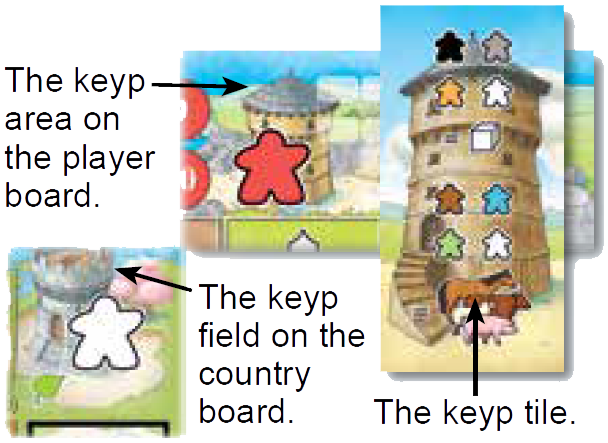
Key icons:
Seasons

Spring

Summer

Autumn

Winter
Gems

Emerald

Gold

Ruby

Sapphire

Any type
Raw materials

Clay

Log

Rock

Clay, log or rock

Any incl. wheat
Finished goods

Brick

Wood

Stone

Brick, wood or stone

Any incl. wheat
Building tiles

Village

Farm

Village and farm

Fair

Requires keyple to activate tile
-
In game controls - there are two buttons that can be used in-game:
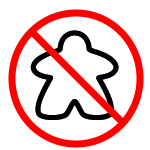
You can hide the already played meeples (on country boards or player boards) to more easily see the tiles underneath them. Click the image to do so. Clicking it again toggles them back on.

You can view the back (upgraded building / fall-winter fair sides) of tiles, in both the tile offer and in your supply of unbuilt tiles. Click the image to do so. Clicking it again toggles them back to their fronts.
- The game uses the term 'leader' for the player who starts an action, and the term 'follower' for a player who adds a joiner.
- As mentioned in the deviations, the game sometimes auto-spends raw resources ahead of finished goods. However, there are times this would be complex to implement. You may be prompted, for example, which resource to spend when performing 'Upgrade raw resources to finished resources', even if you only have one type, because you could (in theory) upgrade a Finished Good to the same Finished Good. E.g., you own 1 clay and 1 brick, the game will ask which you want to upgrade (even though upgrading a brick to a brick is meaningless). This may be improved in a future update.
| |